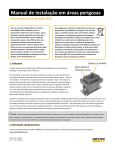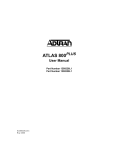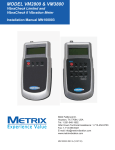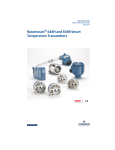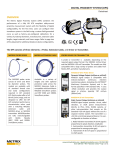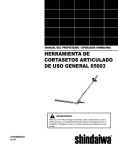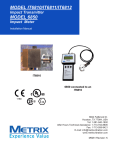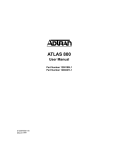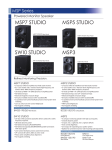Download 5550 & 5550G MECHANICAL VIBRATION SWITCHES Hazardous
Transcript
5550 & 5550G MECHANICAL VIBRATION SWITCHES Hazardous Area Installation Manual Before proceeding to wire and install the Model 5550 switch, read and thoroughly understand these instructions. They are intended for experienced personnel who require only basic installation guidance, and assume that the 5550 has already been selected and applied properly for the machinery at hand. Please contact Metrix or its local representative for additional assistance. See also the “Supplamental Information” section of this manual for additional technical resources available free-of-change on our website at www.metrixvibration.com MODEL 5550 1180 OVERVIEW The Model 5550 Mechanical Vibration Switch offers basic protection against gross changes in structural seismic acceleration. Its operating mechanism is purely mechanical and consists of a tension spring attached to a pivoting plate on an over-center fulcrum – magnets are not employed. Normally, this plate is in an untripped position. However, in the presence of sufficient seismic acceleration (whether vibratory or impact), the trip plate will pivot beyond this over-center position, snapping to a stable tripped position where it contacts an internal microswitch relay, changing the state DOC# M8905 • REV N (Dec 2014) MODEL 5550G 1180 of the relay. This relay is available for external wiring connections where on/off changes in electrical continuity can be used to trip the machine and/or annunciate excessive vibration. Once the switch has assumed its tripped position, it must be reset manually by means of the external reset plunger, or by means of an optional remote electrical reset. The remote reset capability can also be used as a startup delay to hold the switch in an untripped state for as long as coil excitation is supplied – up to 30 seconds (the maximum duration is governed by a non-adjustable, factory-installed thermistor circuit). The startup delay feature is useful during machinery startup when vibration in excess of the normal trip setting may be temporarily incurred. NOTE: The 5550 Mechanical Vibration Switch is not intended for use on high-speed turbomachinery or on machines were changes in seismic acceleration smaller than 1G must be reliably detected. Instead, Metrix offers other electronic vibration sensing solutions that are better suited for such applications. SUPPLEMENTARY INFORMATION Refer to product datasheet 1004461, and operation and maintenance manual 1231558 available at www.metrixvibration.com. MOUNTING Observe the switch nameplate to ensure that it has the correct hazardous approval and environmental ratings for the intended area. Refer to Metrix datasheet 1004461 for a list of all available hazardous area approvals, environmental ratings, and other ordering options. See also the Hazardous Area Approvals section of this manual for hazardous area approvals information. The switch’s sensitive axis is in line with the reset plunger stem. Mount the switch solidly to the machine’s frame such that this axis is aligned with the direction of expected vibratory and/or impact motion. If the machine vibrates along multiple axes (and most machines do), mount the switch to align with the direction of highest vibration. It is typical for machines to vibrate more in the horizontal direction than in the vertical direction, as the foundation normally constrains up-and-down motion more than side-to-side motion. NOTE: Do not attempt to measure vibration or impact perpendicular to the switch’s sensitive axis. The trip plate is free to move along this axis only and will not respond to motion in other directions. Doc# M8905 • REV N (December 2014) Page 2 of 8 CONDUIT When attaching conduit, observe the following: • Avoid long runs of unsupported conduit that can transfer unwanted impacts or vibration of the conduit, rather than of the machine. • Orient conduit such that accumulated moisture or condensation does not drain into the switch and consider the use of J-traps or other drain mechanisms. • Units with NPT conduit holes (ordering option E=1, 2, 3, and 7) have ¾” NPT threads. Units with metric conduit holes (ordering option E=4, 6, and 8) have M20 x 1.5 threads. Refer to datasheet 1004461 for a complete list of ordering options. • Use proper conduit seals meeting the environmental requirement of the installation to prevent ingress of moisture and dust. NOTE: The disposable plastic plugs that ship in each conduit hole provide only physical thread protection during shipping and handling. They are not designed for use as permanent hole plugs and do not provide adequate environmental protection for the switch when installed in the field. WIRING • Remove the cover and wire the switch (es) into the alarm or shutdown circuit. NOTE: Route internal wiring away from the moving part of the switch mechanism and secure so that it cannot move or loosen over time. Wiring that impedes trip plate movement may result in a switch that does not trip properly or at all. • • • • • • Do not exceed switch contact ratings listed on the cover. Observe all local electrical codes. All power must be switched off before opening of the enclosure in an explosive atmosphere. The Vibration Switch must be electrical connected by means of a flameproof/dust cable gland or stopping box certified to: IEC60079-0: 2011(EN60079-0:2012), IEC60079-1: 2007(EN60079-1:2007) and IEC60079-31: 2008(EN60079-31:2009). For ambient temperatures below –10°C, use field wiring suitable for the minimum ambient temperature. Reinstall the cover by first insuring the o-ring is in place and properly seated in the grove in the housing. Place the cover on the unit and install the four cover screws. Torque these screws to 6-7 ft/lbs. NOTE: Do not over-torque the bolts as this could damage the housing and compromise the seal. Doc# M8905 • REV N (December 2014) Page 3 of 8 SETPOINT ADJUSTMENT The setpoint is adjusted by means of a set screw, accessible on the switch’s cover. This set screw makes very small changes to the angle of the internal tension spring, thereby increasing or decreasing the seismic acceleration level required to trip the device. The set screw can be adjusted over a range of approximately 2 full turns (16 g’s peak); a 1/8th turn of this set screw represents approximately 1g and is considered the smallest adjustment for which repeatable results can be obtained. Turn the screw clockwise to increase the setpoint; turn counter-clockwise to decrease the setpoint. The switch orientation is defined as the direction in which the top of the reset plunger faces. The switch ships from the factory with the setpoint at approximately 2g with the switch oriented in the upward vertical position, and 1g when oriented in the horizontal position. The factory default setpoint is not meant to be indicative of allowable vibration on any particular machine or application. It is the responsibility of the user to determine the allowable vibration levels for their machine and adjust the setpoint accordingly. Refer to Metrix 5550 & 5550G User Guide / Installation Manual (doc 1231558) for additional step-by-step guidance on establishing and adjusting the setpoint for your machinery. The manual can be downloaded from www.metrixvibration.com. NOTE: The setpoint is dependent on the switch’s physical orientation. A switch facing upward, downward, and horizontally will trip at three distinctly different acceleration levels for the same set screw adjustment. This is due to the force of gravity and how it will either aid or oppose the relative ease of trip plate motion, depending on switch orientation. For this reason, establish the desired setpoint only when the switch is in its final mounted position. REMOTE RESET AND STARTUP LOCKOUT All Model 5550 Mechanical Switches can be reset locally using the manual reset plunger. Additionally, those fitted with the optional electrical reset circuit can be remotely actuated. The remote reset mechanism consists of an electrical solenoid in series with a thermistor. To reset the switch remotely, apply the rated voltage (see nameplate) to the reset circuit terminals momentarily. This will energize the solenoid and push the trip plate from its tripped position back to its untripped position. Some machines exhibit elevated vibration during startup, above the established trip setpoint for normal operation. To accommodate these situations, the same circuit may also be used to provide a trip lockout during machine startup. Where vibration above the normal trip setpoint may be present temporarily as the machine runs through and it would be otherwise impossible to start the machine without tripping. To use the startup lockout feature, apply the rated voltage to the reset terminals continuously. This will energize the solenoid continuously and keep the switch in its untripped position. The lockout will persist for 30 seconds, or as long as voltage is continuously applied, whichever is shorter (the thermistor in this circuit which will automatically de-energize the solenoid after approximately 30 seconds even if excitation voltage persists at the reset terminals). If the voltage is applied continuously rather than using an external timer or sequencer, please note that the voltage must be removed from the reset circuit when the machine is stopped to allow the thermistor to cool off. If this is not done, it will not be possible to reset the switch remotely. Doc# M8905 • REV N (December 2014) Page 4 of 8 NOTE: If the machine is restarted immediately after a shutdown, the lockout period will be shortened because the thermistor will be hot. An increase in the ambient temperature will also shorten the lockout period. IMPORTANT SAFETY INFORMATION General Safety Summary Review the following safety precautions to avoid injury and prevent damage to this product or any products connected to it. • USE ONLY AS SPECIFIED To avoid potential hazards, use this product only as specified. Only qualified personnel should perform installation and removal procedures. • CONNECT AND DISCONNECT PROPERLY Do not connect or disconnect this product while it is connected to a live power source. • GROUND THE PRODUCT The housing of this product should be connected to earth ground. Before energizing the product, ensure its housing is properly grounded. • OBSERVE ALL TERMINAL RATINGS To avoid fire or shock hazard, observe all ratings and markings on the product. Consult the individual sections of this manual for further information before making connections to the product. • DO NOT OPERATE WITHOUT COVER The cover serves multiple purposes that may include protection against moisture and dust ingression, protection of personnel from electrical shock, and protection against ignition of flammable atmospheres when used in locations with hazardous area ratings. Do not use the device without its cover except when making adjustments or connections as noted in this manual. • AVOID EXPOSURE TO CIRCUITRY Do not touch exposed electrical connections and components when power is present. • DO NOT OPERATE WITH SUSPECT FAILURES If you suspect there is damage to this product, have it inspected by qualified personnel. Doc# M8905 • REV N (December 2014) Page 5 of 8 HAZARDOUS AREA APPROVALS MODEL 5550 IECEx Approval IEC Markings: (World) Ex d IIB + H2 T6 Gb Ex tb IIIC T85°C Db Ta -40°C to +70°C IP66 IECEx BAS10.0020 IEC Standards: ATEX Approval (Europe) EN Standards: ATEX Markings: II 2GD Ex d IIB + H2 T6 Gb Ex tb IIIC T85°C Db Ta -40°C to +70°C IP66 1180 UL Approval (North America) IEC60079-0:2011 IEC60079-1:2007 IEC60079-31:2008 EN60079-0:2012 EN60079-1:2007 EN60079-31:2009 Baseefa 10ATEX0098 UL Markings: UL/CSA Standards: Models 5550-2XX-XXX or 5550-7XX-XXX: UL 508 UL 698 CSA C22.2 No. 14 CSA C22.2 No. 25 CSA C22.2 No. 30 Class I, Div 1, Groups B,C,D, Class II, Div 1, Groups E,F,G, Type 4 or 4X, IP66 Models 5550-1XX-XXX or 5550-6XX-XXX: Class I, Div 1, Groups C,D, Class II, Div 1, Groups E,F,G, Type 4 or 4X, IP66 Doc# M8905 • REV N (December 2014) Page 6 of 8 CAUTION: TO REDUCE RISK OF IGNITION OF HAZARDOUS ATMOSPHERES, DISCONNECT THE SUPPLY CIRCUIT BEFORE OPENING. KEEP ASSEMBLY TIGHTLY CLOSED WHEN IN OPERATION. CABLE TEMPERATURE RISE 15K - USE SUITABLE CABLE. ATTENTION: AFIN DE PREVENTIR L-INFLAMMATION D’ATMOSPHERES DANGEREUSES COUPER L’ALIMENTATION ELECTRIQUE CIRCUIT AVANT D’OUVRIR COFFRET GARDER LE COUVERCLE BIEN FERMETANT QUE LES CIRCUITS SONT SOUS TONSION. TEMPERATURE DE CABLE MONTE 15K - UTILISEZ CABLE APPROPRIE MODEL 5550G IECEx Approval IEC Markings: (World): Ex d IIC T6 Gb Ex tb IIIC T85°C Db Ta -40°C to +70°C IP66 IECEx BAS10.0095X IEC Standards: IEC60079-0:2011 IEC600079-1:2007 IEC600079-31:2008 ATEX Approval (Europe): EN Standards: EN60079-0:2012 EN60079-1:2007 EN60079-31:2009 ATEX Markings: II 2GD Ex d IIC T6 Gb Ex tb IIIC T85°C Db Ta -40°C to +70°C IP66 1180 Baseefa 10ATEX0177 CAUTION: TO REDUCE RISK OF IGNITION OF HAZARDOUS ATMOSPHERES, DISCONNECT THE SUPPLY CIRCUIT BEFORE OPENING. KEEP ASSEMBLY TIGHTLY CLOSED WHEN IN OPERATION. CABLE TEMPERATURE RISE 15K - USE SUITABLE CABLE. ATTENTION: AFIN DE PREVENTIR L-INFLAMMATION D’ATMOSPHERES DANGEREUSES COUPER L’ALIMENTATION ELECTRIQUE CIRCUIT AVANT D’OUVRIR COFFRET GARDER LE COUVERCLE BIEN FERMETANT QUE LES CIRCUITS SONT SOUS TENSION. TEMPERATURE DE CABLE MONTE 15K - UTILISEZ CABLE APPROPRIE. Doc# M8905 • REV N (December 2014) Page 7 of 8 ENVIRONMENTAL INFORMATION This electronic equipment was manufactured according to high quality standards to ensure safe and reliable operation when used as intended. Due to its nature, this equipment may contain small quantities of substances known to be hazardous to the environment or to human health if released into the environment. For this reason, Waste Electrical and Electronic Equipment (commonly known as WEEE) should never be disposed of in the public waste stream. The “Crossed-Out Waste Bin” label affixed to this product is a reminder to dispose of this product in accordance with local WEEE regulations. If you have questions about the disposal process, please contact Metrix Customer Service. [email protected] www.metrixvibration.com 8824 Fallbrook Dr. Houston, TX 77064, USA Tel: 1.281.940.1802 • Fax: 1.713.559.9421 After Hours (CST) Technical Assistance: 1.713.452.9703 Doc# M8905 • REV N (December 2014) Page 8 of 8









